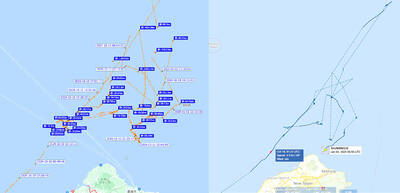The cost growth rate of ventilators used by long-term patients has decelerated in the past five years due to effective cost control measures, the Bureau of National Health Insurance (NHI) said.
The bureau said that between 2008 and last year, annual spending on ventilator-dependent patients was between NT$26.1 billion (US$878 million) and NT$27 billion, with a cost growth rate of 1 percent, lower than total healthcare spending growth of 4.25 percent.
Through repeated revisions of the payment system, the effective management of patients’ inter-hospital moves, supervision of the quality of nursing care and check-ups by specialist physicians, the annual cost growth rate has been reduced from 20 percent to 1 percent, the bureau said.
Alongside this large reduction, an increasing number of patients are being weened off ventilators, from 31 percent to 45 percent, and the mortality rate has decreased from 56 percent to 45 percent.
The second-generation NHI is aiming to streamline use of medical resources, and controlling the cost of ventilators used by long-term users is a crucial part of acheiving this goal which involves cooperation on the part of the hospitals.
However, public awareness of hospices is another aspect that needs to be developed and it is to this end that an amendment to the Hospice Palliative Care Act (安寧緩和醫療條例) was made to lower the threshold for withdrawing life-sustaining medical treatment for terminally ill patients, the bureau said.
Under the amended act, a terminal diagnosis confirmed by two specialist physicians and a letter of intent signed by the patient are the only two requirements needed for the withholding of cardiopulmonary resuscitation performance and the removal of life-support.
If no such letter or other advanced directives were signed or written and the patient lacks decisionmaking capacity, only one immediate family member’s consent is needed for discontinuing life-sustaining treatment.
In either case, the hospital’s medical ethics committee, whose approval was required before, is excluded from the decisionmaking process.
The bureau said that the increasing number of people who registered for the hospice palliative treatment, from 22,548 in 2008 to the current 144,986, shows that there has increased in public awareness.
According to the NHI database, most long-term ventilator-dependent patients were in intensive-care when they first received ventilator tubes. However, they became ventilator-dependent after receiving treatment.
The bureau said that if patients, their families and the intensive care unit staff can hold a proper discussion about the matter beforehand, there is a possibility the ventilator usage rate can decrease significantly.
The bureau said it started to provide consultation services in February last year to such patients and families, aiming to lessen both the financial burden generated by futile medical care and the drawn-out suffering endured by bedridden patients.

DEEPER REVIEW: After receiving 19 hospital reports of suspected food poisoning, the Taipei Department of Health applied for an epidemiological investigation A buffet restaurant in Taipei’s Xinyi District (信義) is to be fined NT$3 million (US$91,233) after it remained opened despite an order to suspend operations following reports that 32 people had been treated for suspected food poisoning, the Taipei Department of Health said yesterday. The health department said it on Tuesday received reports from hospitals of people who had suspected food poisoning symptoms, including nausea, vomiting, stomach pain and diarrhea, after they ate at an INPARADISE (饗饗) branch in Breeze Xinyi on Sunday and Monday. As more than six people who ate at the restaurant sought medical treatment, the department ordered the

A strong continental cold air mass and abundant moisture bringing snow to mountains 3,000m and higher over the past few days are a reminder that more than 60 years ago Taiwan had an outdoor ski resort that gradually disappeared in part due to climate change. On Oct. 24, 2021, the National Development Council posted a series of photographs on Facebook recounting the days when Taiwan had a ski resort on Hehuanshan (合歡山) in Nantou County. More than 60 years ago, when developing a branch of the Central Cross-Island Highway, the government discovered that Hehuanshan, with an elevation of more than 3,100m,

Taiwan’s population last year shrank further and births continued to decline to a yearly low, the Ministry of the Interior announced today. The ministry published the 2024 population demographics statistics, highlighting record lows in births and bringing attention to Taiwan’s aging population. The nation’s population last year stood at 23,400,220, a decrease of 20,222 individuals compared to 2023. Last year, there were 134,856 births, representing a crude birth rate of 5.76 per 1,000 people, a slight decline from 2023’s 135,571 births and 5.81 crude birth rate. This decrease of 715 births resulted in a new record low per the ministry’s data. Since 2016, which saw

SECURITY: To protect the nation’s Internet cables, the navy should use buoys marking waters within 50m of them as a restricted zone, a former navy squadron commander said A Chinese cargo ship repeatedly intruded into Taiwan’s contiguous and sovereign waters for three months before allegedly damaging an undersea Internet cable off Kaohsiung, a Liberty Times (sister paper of the Taipei Times) investigation revealed. Using publicly available information, the Liberty Times was able to reconstruct the Shunxing-39’s movements near Taiwan since Double Ten National Day last year. Taiwanese officials did not respond to the freighter’s intrusions until Friday last week, when the ship, registered in Cameroon and Tanzania, turned off its automatic identification system shortly before damage was inflicted to a key cable linking Taiwan to the rest of